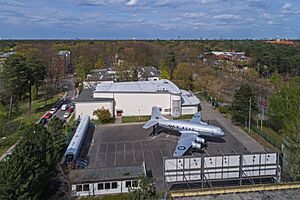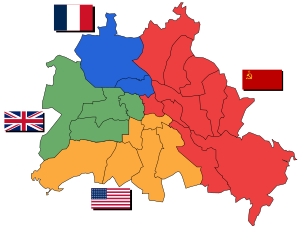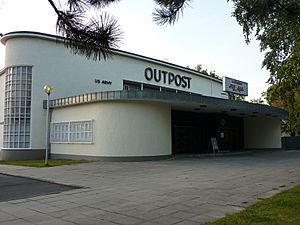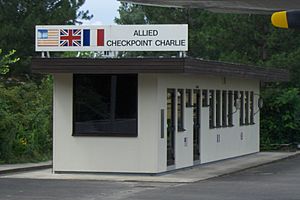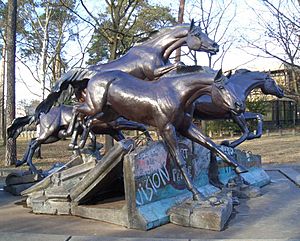Allied Museum facts for kids
Lua error in Module:Location_map at line 420: attempt to index field 'wikibase' (a nil value). The Allied Museum (German: AlliiertenMuseum) is a special museum in Berlin, Germany. It tells the story of the Western Allies – the US, France, and the United Kingdom. These countries played a big part in Germany, especially Berlin, from 1945 to 1994. The museum shows how they helped keep freedom in Berlin during the Cold War.
Contents
Where to Find the Allied Museum
The museum is located on Clayallee, a street named after General Lucius D. Clay. This area is in the Dahlem part of Berlin. Before German reunification in 1990, this was the American sector of West Berlin.
The buildings used to be an American movie theater called Outpost. There was also the Nicholson Memorial Library. The museum opened in 1998. This was 50 years after the Berlin Airlift. Entrance to the museum is free for everyone.
Since Berlin Tempelhof Airport closed in 2008, the museum has thought about moving there.
The Allies and the Cold War
The museum shares an important part of the Cold War story in Berlin. This period started right after World War II. It ended when the Allied forces left in the 1990s.
After World War II, in February 1945, the United States, United Kingdom, and Soviet Union met. At the Yalta Conference, they decided to divide Germany into occupation zones. France also got a zone. The German capital, Berlin, was also split into four parts.
In April 1945, Soviet Red Army soldiers fought their way into Berlin. They made the German army surrender. Later that summer, the Soviets moved out of the Western parts of the city.
Soon, a conflict began between East and West. The Soviet Union left the group that managed Berlin. Then, in 1948–49, they started the Berlin Blockade. This meant the US, UK, and France became the Western Allies. They stood against the Soviet forces.
Tensions grew, leading to the Berlin Crisis of 1961. This is when the Berlin Wall was built. Things got better with the 1971 Four Power Agreement on Berlin. The "Berlin question" was finally solved after the Peaceful Revolution in East Germany. The Berlin Wall fell on November 9, 1989.
What You Can See at the Museum
The Outpost Theater: From War to Airlift
The old Outpost movie theater was built in 1953. It is now a protected building. Inside, you can see maps of Berlin's planned sectors. There are also pictures of the Red Army entering Berlin. You can see old uniforms and the first newspapers from after the war. Documents about removing Nazi ideas are also on display.
A big part of this section is about the Berlin Airlift. This was when British and American planes flew supplies into West Berlin. It shows the hard work and sacrifices made. The museum also holds talks and shows movies here.
Outside Exhibits: Planes and a Watchtower
Outside, you can see some of the biggest items in the museum. These include a Handley Page Hastings transport plane. The Royal Air Force used this plane during the Berlin Airlift. There is also a railway car from a French military train.
You can also see the last guard house from Checkpoint Charlie. This was a famous border crossing in Berlin. There is also a rebuilt East German watchtower.
Nicholson Memorial Library: Berlin's Special Role
The former library building shows documents about the daily lives of Allied soldiers. It also covers the political situation during the Cold War. You can learn how the US, Great Britain, and France kept control in West Berlin.
The collections include a recreated spy tunnel. This tunnel was built during Operation Gold in 1955. American and British intelligence services used it. Part of the hall is used for special temporary exhibits. These exhibits focus on important topics today.
How the Museum is Organized
The Allied Museum is a non-profit group. Its members include Germany, the state of Berlin, France, the UK, and the US. Other members are the Deutsches Historisches Museum and the Institut für Zeitgeschichte in Munich.
The Day the Wall Came Down Sculpture
Near the Allied Museum, you can see a sculpture called The Day the Wall Came Down. Artist Veryl Goodnight created it in 1998. It celebrates November 9, 1989, when the Berlin Wall lost its power. The sculpture shows five wild horses jumping over real pieces of the wall. A statue of General Friedrich Wilhelm von Steuben is also nearby.
More to Explore
- German-Russian Museum
- List of museums and galleries in Berlin


